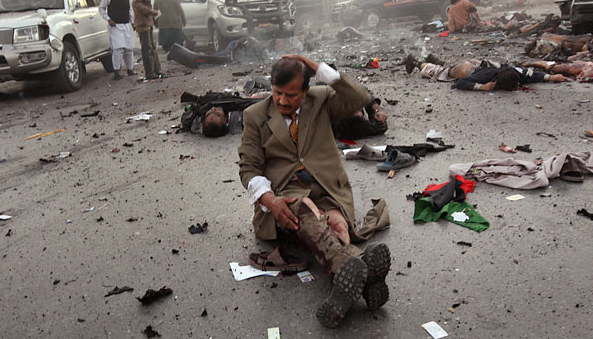I’ve posted before about the heroism of the Pakistani middle class as they confront terror to create a modern, liberal-democratic civil society. That post featured an image of waiting and the prospect that things could get worse. They did get worse:
This photograph is centered on a man wounded in the fatal attack on Benazir Bhutto in Rawalpindi, Pakistan. It shows much more than that, however. I see the pathos of civil society in an era of violence, a scene that can be understood as both a series of small choices and the brutal logic of historical fatality.
The photo features the man in the middle of the frame, and he is a peculiar figure: at once a picture of bourgeois composure and someone blasted into stunned incongruity. His pants have been shredded by the blast of the suicide bomber, yet his suit is still buttoned and his tie knotted neatly. One sleeve is disheveled but only to reveal a crisp shirt with white French cuffs. He checks his head for damage yet his hair is still parted. Those around him have been leveled by shrapnel, but he is sitting upright with his legs crossed at the ankles; he could just as well be sitting in a barber’s chair.
The emotional appeal of the image may derive from this tension between the raw violence of the scene and the habitual routines of ordinary life. This tension might be concentrated in the contrast between his orderly demeanor and exposed flesh. He acts as if the only problem is whether his hair is mussed, while we see that his pants have been flayed by violence. Much is revealed: he is not just a “suit,” and a “stable” society is not one where anyone can be torn apart by others who are no respecter of persons. More to the point, his habits of dress, posture, gesture, and thought are both touching and out of place in a world blown apart. They are so far from the harsh realities of civil war, so foreign to the production of violence. His habits are nothing more or less than than consolidated choices that both assume and reproduce a decent civil society. They are isolated by the destruction around him, and the implication is that they may be useless.
Although his suit didn’t protect him, he is alive. And that sets up the second emotional vector in the image. As the street spreads out behind him, we see the carnage wrought by the bomb. You might not want to look too closely. Those lying behind him are dead, and the further into the background, the more broken the bodies. Again, the scene is marked by little signs of normalcy gone awry: strips of paper, items of clothing, it could be the aftermath of a tornado except that it doesn’t stop there. The sitting man, the prone body, the crumpled bodies, the body parts present a declension of violence: to wound, to kill, to kill and mutilate, to dismember, to blow to bits. Thus, the distance from the man in the foreground to whose scattered on the ground behind him can double as a series of steps as a society devolves into anarchy. Those who are committed to civic order are threatened, then attacked, then killed as everything associated with them also is shredded and scattered. Small choices and everyday habits that are the fabric of peace cannot withstand the weapons of those committed to destruction.
John and I have posted periodically about the normalization of violence, but that rarely occurs in the immediate presence of actual destruction. This photograph documents that violence itself is about anything but the taken for granted routines of ordinary life. We now seem to be in a season of violence–Iraq, Pakistan, Kenya, and others are suffering the destruction of social order. It seems that the process is irreversible: once the detonator is set off, waves of destruction spread ever outward. But look at the photograph one last time. There are others in the picture. In the rear, another of the wounded also has risen to a sitting position. On the side, there are onlookers. These figures suggest that fatality has limits. The swath of destruction went only so far this time, each time. Those watching still have choices to make. Who to side with. How to help. With what weapons.

Discussion